
Limburg an der Lahn is the district seat of Limburg-Weilburg in Hesse, Germany.
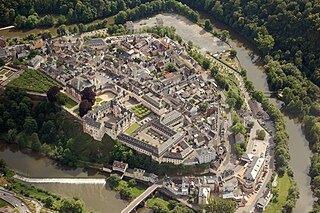
Weilburg is, with just under 14,000 inhabitants, the third biggest city in Limburg-Weilburg district in Hesse, Germany, after Limburg an der Lahn and Bad Camberg.

Elz is a municipality in Limburg-Weilburg district in western Hesse, Germany, on the boundary with Rhineland-Palatinate.

Selters (Taunus) is a municipality with 8,000 inhabitants north of Bad Camberg in Limburg-Weilburg district in Hesse, Germany.
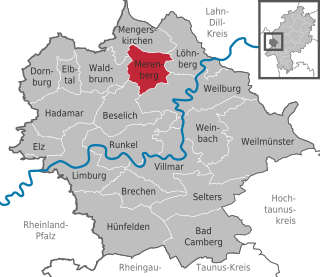
Merenberg is a municipality in Limburg-Weilburg district in Hesse, Germany.

Bad Camberg is, with 15,000 inhabitants, the second largest town in Limburg-Weilburg district in Hesse, Germany, as well as the southernmost town in the Regierungsbezirk of Gießen. It is located in the eastern Taunus in the Goldener Grund some 30 km north of Wiesbaden, 18 km southeast of Limburg an der Lahn, and 44 km northwest of Frankfurt, as well as on the German Timber-Frame Road. Bad Camberg is the central community of the Goldener Grund with good infrastructure, and a lower centre partly with a middle centre's function.
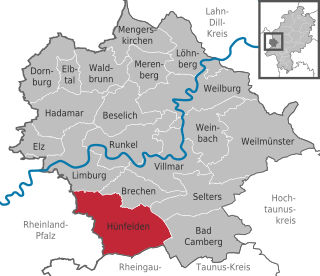
Hünfelden is a municipality in Limburg-Weilburg district in Hesse, Germany. Hünfelden lies on the Hühnerstraße, an historic part of Bundesstraße 417.
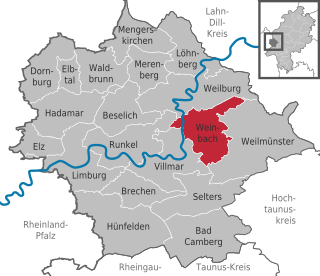
Weinbach is a municipality in Limburg-Weilburg district in Hesse, Germany.

Runkel is a town on the river Lahn in Limburg-Weilburg district in Hesse, Germany.

Weilmünster is a municipality in Limburg-Weilburg district in Hesse, Germany.

Beselich is a municipality in Limburg-Weilburg district in Hesse, Germany.
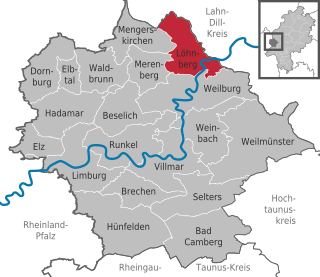
Löhnberg is a municipality north of Weilburg in Limburg-Weilburg district in Hesse, Germany.

Mengerskirchen is a municipality in Limburg-Weilburg district in Hesse, Germany.

Villmar is a market village and municipality in the Limburg-Weilburg district in Hesse, Germany. The community is the centre for quarrying and processing the so-called Lahn Marble.

Waldems is a municipality in the Rheingau-Taunus-Kreis in the Regierungsbezirk of Darmstadt in Hesse, Germany. The municipality's administrative seat is Waldems-Esch.

Nentershausen is an Ortsgemeinde – a community belonging to a Verbandsgemeinde – in the Westerwaldkreis in Rhineland-Palatinate, Germany.

Molsberg is an Ortsgemeinde – a community belonging to a Verbandsgemeinde – in the Westerwaldkreis in Rhineland-Palatinate, Germany.
The Countship of Isenburg-Limburg was a state of the Holy Roman Empire in the 13th and 14th centuries, based around the city of Limburg an der Lahn in modern Hesse, Germany.

Dietkirchen an der Lahn is a borough (Ortsbezirk) of Limburg an der Lahn, seat of the district of Limburg-Weilburg in the state of Hesse, Germany. The formerly independent village was incorporated into Limburg in 1971. The town is dominated by the basilica St. Lubentius, which was the most important early-medieval church building in the region.
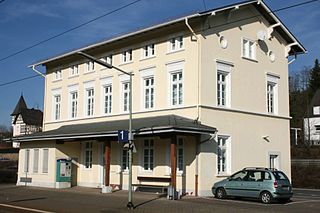
Oberbrechen station is a station on the Main-Lahn Railway, which runs from Frankfurt (Main) Hauptbahnhof to Limburg (Lahn), in the Brechen suburb of Niederbrechen in the German state of Hesse. With Niederbrechen station, it is one of two stations in Brechen. The station is in the network of the Rhein-Main-Verkehrsverbund (RMV) and is classified by Deutsche Bahn as a category 6 station and has two platform tracks.


























